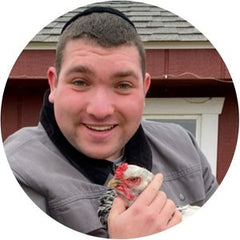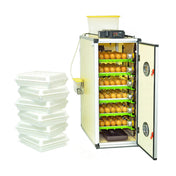Table of Contents
There are so many different aspects of keeping poultry, that it can be overwhelming for the novice. In this article you will learn what you need to provide your poultry to be successful. Successful poultry keeping and raising backyard chickens can be summed up in three words: food, water, shelter. If you provide these three key elements, you will be successful in keeping poultry. Always purchase healthy poultry or poultry eggs from a hatchery or breeder who is NPIP certified. When purchasing from farms or hobbyists make sure the birds on site are pest free and disease free.

Types of Poultry & Why Raise Backyard Poultry
When people think of poultry they usually think of chickens and sometimes turkeys. However, quail, ducks, geese, pheasants, guinea fowl, and peafowl are all considered poultry as well. The most beginner friendly and easy poultry to raise are chickens and quail. More people than ever are raising poultry for eggs or meat. The vast majority of hobbyists, backyard chicken owners, and homesteaders raise poultry for the fresh eggs. In case of asking why do we raise poultry, chickens are wonderful pets as they recognize faces and the voice of their owner. In addition, they have great personalities and are quite smart birds.
Reason to have a backyard flock or raising poultry boils down to your values. Many consumers today are very conscious-minded and particular about where their food comes from. People want to know the living conditions and diets of the chickens who lay the eggs that they eat. They want to know that the chickens were raised with enough room to express their natural behaviors. Look at the countless options of eggs at the supermarket; cage free, free range, vegetarian fed, etc. Many decide that raising their own poultry is the only way to ensure that they provide themselves and their families with the healthiest eggs possible.

Your First Poultry
If you decide to hatch your own poultry and answered why raise backyard chickens, you will need an chick incubator, brooder, and grow out pens before your poultry are ready to live outside. Hatching your first poultry can be rewarding and a great introduction into poultry keeping. If you get day old baby chicks you will need a brooder and grow out pens for them as they get older. Brooding chicks is a very enjoyable process, especially when children are involved. Make sure that you have all the supplies and proper feed and electrolytes when you are planning to purchase or hatch out poultry chicks.
Check out Preparing Chicks for Brooder for a comprehensive article on brooding poultry! Another great way to brood poultry is to allow a broody hen to do the job for you. There is nothing that makes me smile like seeing a hen with her chicks. If you get started pullets or point of lay pullets they will be ready to go outside right away. It can be helpful to keep your new pullets in the coop for a week or two until they realize that the coop is their home.

Food & Water
When poultry species are young, they require a starter feed until they are six to eight weeks of age. This starter feed provides them with the correct nutritional balance of vitamins, minerals, and proteins so that they will grow into healthy and productive birds. When your poultry are six to eight weeks old, start to feed them grower feed. Grower feed contains a higher level of protein to accommodate the rapid feather and body growth the birds. Depending on species, you should continue to provide grower feed until your birds start to lay or your females become sexually mature. The consensus among the majority of poultry keepers is to feed a layer ration for quail when they are seven or eight weeks old, chickens at sixteen weeks old, and duck hens when they are five months old. Laying birds need calcium to produce strong eggshells. Layer feed already contains the needed amount of calcium, but many owners mix crushed oyster shell with the feed.
I love to utilize Poultry feeders to keep the feed off the ground. Poultry require fresh clean water year-round. For poultry owners who live in areas that have winter temperatures below freezing, heated waterers are a life saver! Poultry will drink more water in the hot summer months as they need to hydrate and cool themselves. If pullets or hens go without water for more than twenty-four hours, irreparable damage will be done to their laying ability. If you raise more than twenty poultry in a single area consider having more than one water and food source or install a feed silo and a water silo.

Shelter
Lastly, poultry require a predator proof shelter to live and lay their eggs in. The henhouse and the run are collectively referred to as the coop. The henhouse is the structure where your poultry sleep, most poultry will lay their eggs in nest boxes. The henhouse needs to be a draft proof, but ventilated and a sturdy structure. Chickens require twelve to eighteen inches of roost space per bird and one nest box for every three laying birds. The run is the wire enclosed structure that surrounds or is attached to the henhouse. The wire used for the run walls should be half inch by half inch hardware cloth to ensure that predators cannot reach in and attack your birds.
Chicken wire should never be used for securing poultry, it is much too flexible and the gaps are too large to adequately protect poultry. A covered run is a must to prevent aerial attacks by hawks and to stop predators climbing into the run. A run can be covered by solid material like plywood or corrugated plastic or metal. One inch by two inch wire or two inch by four inch wire works very well as a run cover. Large fowl chickens require eight to ten square feet per bird in the run, while bantams require two and a half to four square feet per bird in the run. A ten by ten foot run is one hundred square feet and can accommodate ten to twelve large fowl chickens or up to twenty-five bantam chickens. It is always smart to build your poultry coop larger than the number of birds you plan to start with.
Written by:

Aryeh Wiesel








